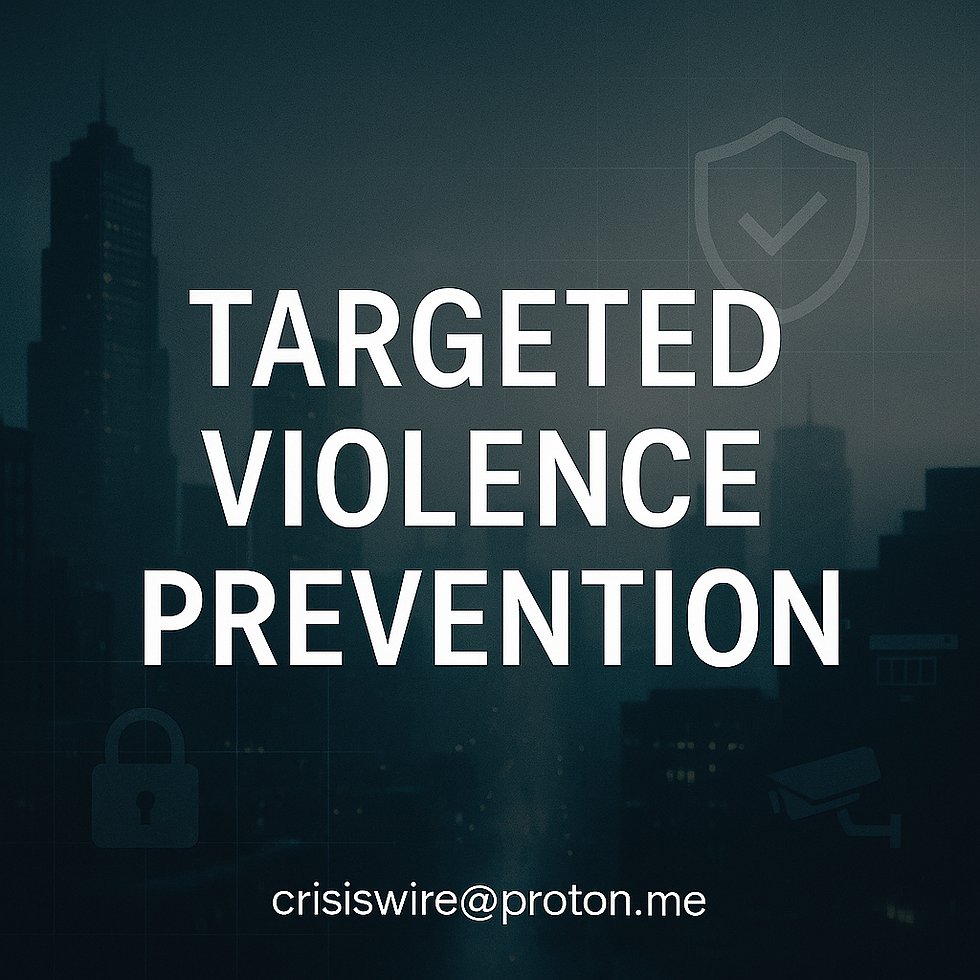Hawaiʻi Targeted Violence Prevention: How CrisisWire Strengthens the State’s Mission
- CrisisWire

- Oct 6
- 2 min read
What the State Covers — and What’s Missing
The Office of Homeland Security (OHS) has launched a Targeted Violence Prevention (TVP) program to prevent violence before it happens. Hawaiʻi’s model uses a public-health lens, with certified trainers helping build Behavioral Threat Assessment and Management (BTAM) teams across institutions.
But public programs are not designed to replace private, professional threat assessments. Gaps remain in hospitals, schools, and corporate settings. That’s where CrisisWire Threat Management Solutions bridges the divide.

Deep Analysis: What TVP Provides vs. Where CrisisWire Adds Value
State Coverage
2022 Hawaiʻi TVP Strategy
$803,330 DHS grant awarded to expand training (OHS release)
Limitations
Public focus on imminent violence only.
Lack of deep-dive insider threat auditing.
Generic, not tailored to individual organizations.
CrisisWire Value Add
Custom audits: schools, hospitals, SMBs.
Integration with FEMA Continuity Guidelines.
Cyber-physical reviews aligned with CISA standards.
CEO/board liability briefings per Leadership Liability in Crisis (Scribd).
Case Studies: Real-World Gaps
Schools: State BTAM training reduces imminent risks, but systemic gaps remain. CrisisWire adds visitor management audits, as detailed in School Threat Assessments 2025 (Academia.edu) and School Threat Assessments 2025 (Archive.org).
Hospitals: OHS does not provide internal audits for HIPAA/data access risks. CrisisWire builds on research like Insider Threats in Hospitals (Academia.edu) and Insider Threats in Hospitals (Scribd).
Corporations: Public programs don’t cover insider risks or ransomware. CrisisWire draws from SMB Survival vs Collapse (Archive.org) and Insider Threat Audit 10 Steps (Academia.edu).
📺 Video resources: CrisisWire Video 1 and CrisisWire Video 2 show why organizations can’t ignore insider risk in practice.
Actionable Playbook: CrisisWire + TVP Integration
Gap Analysis — compare institutional weaknesses against OHS TVP goals.
Insider Threat Assessment — audits linked to Executive Protection 2025 (Academia.edu).
Emergency Planning — continuity planning rooted in Business Continuity Playbook (Archive.org).
Leadership Liability — briefing for CEOs with reference to The Prepared Leader (Amazon).
Visitor Management — leverage insights from your own Visitor Audit blog.
Leadership Liability: Why Blended Models Are Required
Courts expect documented due diligence.
OHS programs offer training, but CEOs still need audits to avoid liability.
As Campus Under Siege (Amazon) and Locked Down Blueprint (Amazon) argue, leaders who skip assessments face existential risks.
The CrisisWire Advantage
Hawaiʻi-based expertise with national reach.
Former LAPD, DHS/FEMA-certified, WPS/WPPS contract veteran.
Internal blog integration: Service Expansion, Threat Assessment Books.
Academic + archival references: Academia.edu, Archive.org, Scribd.
📘 Partner with CrisisWire to amplify Hawaiʻi’s Targeted Violence Prevention strategy with real-world, institutional threat assessments.
📧 Contact: crisiswire@proton.me
#CrisisWire #HawaiiSecurity #TargetedViolencePrevention #ThreatAssessment #SchoolSafety #CorporateSecurity #HospitalSecurity
FAQ
Q1: Does CrisisWire replace the Hawaiʻi Threat Team? No — we complement it with private, systemic audits.
Q2: What’s the difference between OHS TVP and CrisisWire? OHS provides statewide training; CrisisWire ensures individual institutions are compliant and resilient.
Q3: Can SMBs afford this? Yes — we offer flat-rate packages tailored to schools, SMBs, and hospitals.





Comments